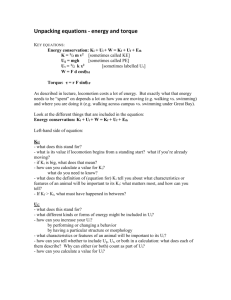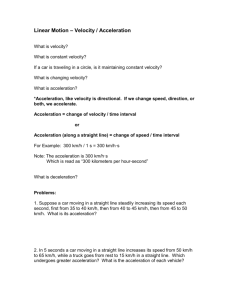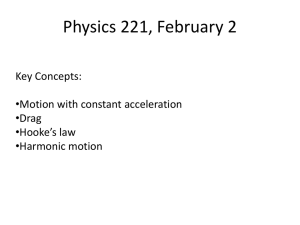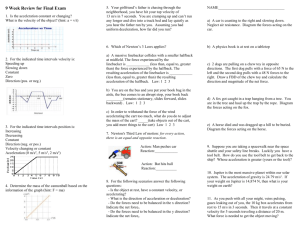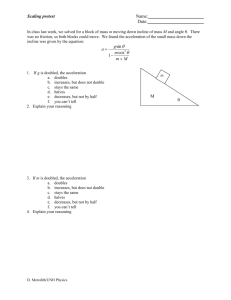Topic Coverage Rationale
advertisement
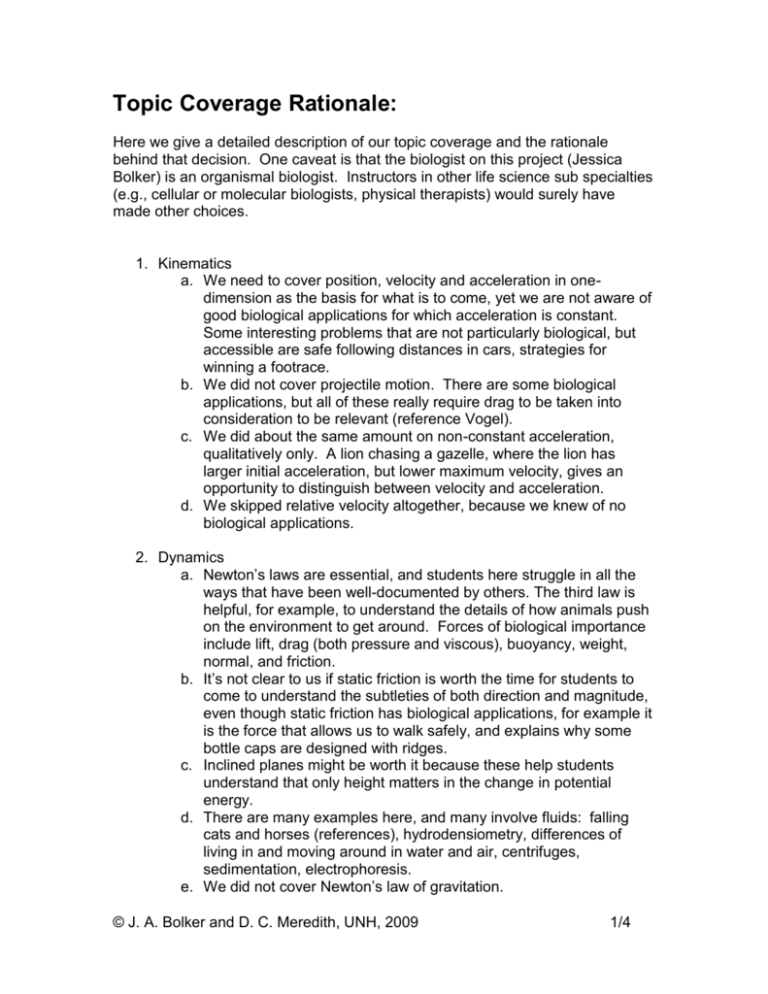
Topic Coverage Rationale: Here we give a detailed description of our topic coverage and the rationale behind that decision. One caveat is that the biologist on this project (Jessica Bolker) is an organismal biologist. Instructors in other life science sub specialties (e.g., cellular or molecular biologists, physical therapists) would surely have made other choices. 1. Kinematics a. We need to cover position, velocity and acceleration in onedimension as the basis for what is to come, yet we are not aware of good biological applications for which acceleration is constant. Some interesting problems that are not particularly biological, but accessible are safe following distances in cars, strategies for winning a footrace. b. We did not cover projectile motion. There are some biological applications, but all of these really require drag to be taken into consideration to be relevant (reference Vogel). c. We did about the same amount on non-constant acceleration, qualitatively only. A lion chasing a gazelle, where the lion has larger initial acceleration, but lower maximum velocity, gives an opportunity to distinguish between velocity and acceleration. d. We skipped relative velocity altogether, because we knew of no biological applications. 2. Dynamics a. Newton’s laws are essential, and students here struggle in all the ways that have been well-documented by others. The third law is helpful, for example, to understand the details of how animals push on the environment to get around. Forces of biological importance include lift, drag (both pressure and viscous), buoyancy, weight, normal, and friction. b. It’s not clear to us if static friction is worth the time for students to come to understand the subtleties of both direction and magnitude, even though static friction has biological applications, for example it is the force that allows us to walk safely, and explains why some bottle caps are designed with ridges. c. Inclined planes might be worth it because these help students understand that only height matters in the change in potential energy. d. There are many examples here, and many involve fluids: falling cats and horses (references), hydrodensiometry, differences of living in and moving around in water and air, centrifuges, sedimentation, electrophoresis. e. We did not cover Newton’s law of gravitation. © J. A. Bolker and D. C. Meredith, UNH, 2009 1/4 Topic Coverage Rationale 3. Rotational motion a. We did far less on circular motion and rotations. Full rotations are very uncommon in biology; two exceptions we are aware of are for instrumentation: centrifuges and mass spectrometers. b. We only covered torque in equilibrium situations. Biological applications include the torque required at equilibrium for both elbow and back muscles, understanding the differences in leg anatomy between runners (gazelles) and diggers (armadillos) and differences in jaw bones between those that need to snap and those that need to chew. 4. Momentum conservation a. The main focus here was to use momentum conservation to understand locomotion, and that the organism must push on the environment to move. We did only one-dimensional problems, and did not add in energy conservation since in locomotion mechanical energy is typically not conserved. Interesting applications include hovering hummingbirds and jetting jellyfish. 5. Materials a. This is not usually covered in physics courses, but has many biological applications. The topics include stress/strain curves, energy considerations in crack propagation, and properties of a few key biological materials: pre-stressed trees, collagen, bones, tendon and teeth. This is one important biological application of both force and energy. b. Labs included labs on tension and compression with students modeling stress/strain curves. 6. Energy a. The coverage of energy is largely unchanged. There are many biological applications: organisms have to worry a great deal about how to survive on a limited energy budget; energy transformations (from chemical to kinetic and gravitational) are essential for understanding biological systems; the cost of staying warm for mammals is significant. 7. Fluids a. Here we increased standard coverage, since fluids are essential for life, both inside and outside organisms. Viscous drag and Poiseuille’s equation for the change in pressure in a pipe due to viscosity are important for discussing blood flow. Surface tension would be good to include, though we did not. We have some evidence that Bernoulli’s equation is not key to biology; for example, pressure changes in the body due to velocity changes are negligible compared to pressure changes due to height changes. © J. A. Bolker and D. C. Meredith, UNH, 2009 2/4 Topic Coverage Rationale b. Labs included viscosity lab to measure viscous drag, based on terminal velocity. 8. Thermodynamics a. Kinetic theory of gases was covered to pave the way to talk about energy budget =kT for molecules within cells. b. Heat transfer mechanisms and calorimetry are important to understand how animals keep warm or cool off, as necessary. Discussion of insulation, evaporation, retes (for efficient heat exchange) and issues of size are important here. c. Entropy is essential for life and should be covered. We did not, due to time constraints. d. We did not cover heat engines, and do not see any good biological application related to such engines. 9. Moving molecules a. This is a completely new, and perhaps idiosyncratic presentation of the material. We chose to organize it in this way in order to talk about the various ways that molecules (e.g. oxygen, chemical signals) move around. This includes diffusion, conduction and convection. We put this topic next to thermodynamics because of the similarities in heat conduction and convection. Size issues are important here: large animals have to be designed differently than small animals because diffusion works only over very short distances. The Nernst potential across cell walls can be discussed here. b. The standard cooling lab has been modified to focus on helping students make sense of the parameters in Newton’s Law of Cooling. 10. Waves and simple harmonic motion a. Simple harmonic motion itself has a few applications (e.g. resonance of the ear drum), but serves as a basis to understand waves. We know that making sense of trigonometric functions is non-trivial, so it seems best to start with a simpler example. b. Wave motion (light and sound) is absolutely essential for biologists. Applications include bat echolocation; sound production, transmission and reception in animals; color production, transmission and reception; eyes; microscopes; lenses; ultrasound. While there are some biological uses of diffraction (e.g. structural color) it is not clear to us that this is the best use of time in this class, as the mathematics is quite challenging. c. Reflection and transmission (for how much sound/light waves transmit) through lenses, through ultrasound. © J. A. Bolker and D. C. Meredith, UNH, 2009 3/4 Topic Coverage Rationale 11. Electric force and potential a. Here the focus is different than in engineering courses. Understanding conceptually about electric fields, force, and potential has applications in electric fish, electrophoresis, and aggregation. 12. Magnetism a. This was covered mostly conceptually, with quantitative work done based only on the Lorentz force. Applications include the mass spectrometer and NMR. b. Induction is covered qualitatively, as it is used in many applications such as charging pacemakers and toothbrushes. 13. Circuits a. The level of coverage is about the same as in a standard college text, since circuits are a part of much biological instrumentation. Biological applications include electrical safety, nerve cell signals, and PCR. 14. Atomic and nuclear physics a. We do just enough atomic, molecular and nuclear physics to be able to talk about medical imaging and florescence as a measuring tool (in the ocean, in electrophoresis, etc). 15. Relativity a. Not covered at all © J. A. Bolker and D. C. Meredith, UNH, 2009 4/4


